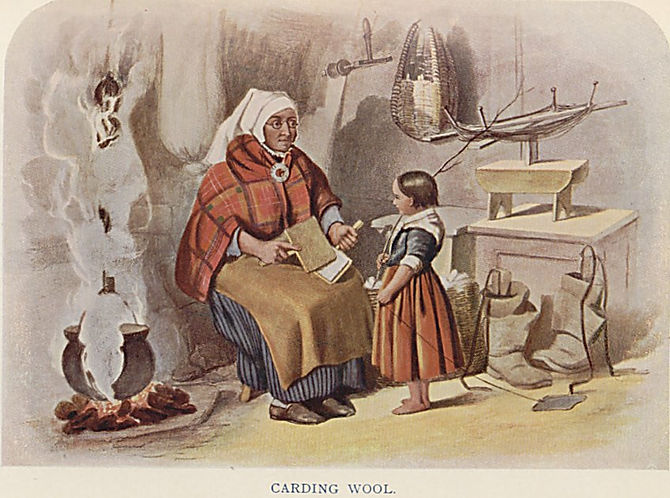




WELCOME TO AN ENTERTAINMENT SITE FOR SCOTTISH COUNTRY DANCERS!
Enjoy this curated selection of theme-related dances for celebrations and holidays, or find a dance associated with a special calendar day, or EVEN your own birthday!
Carding Wool, R. R. MacIan - The Highlanders at Home (1848)
Oct 5

Wool Week
Card It Weil
Other Scottish Country Dances for this Day
Today's Musings, History & Folklore
"🎶 Baa, baa, black sheep
Have you any wool?
Yes sir, yes sir, three bags full."
~ Mother Goose
Shetland Wool Week is a world renowned celebration of Britain’s most northerly native sheep, the Shetland textile industry and the rural farming community on the Shetland islands. Whether by hand or machinery, in preparing wool fiber for spinning, carding is the step that comes after teasing, and prepares the wool for spinning. "Carding" is derived from the Latin carduus meaning thistle or teasel, as dried teasels were the first items used to comb the raw wool. Carding breaks up locks and unorganised clumps of fibre and then aligns the individual fibers to be parallel with each other. Carding of wool can either be done "in the grease" or not, depending on the type of machine and on the spinner's preference. "In the grease" refers to the naturally occurring lanolin oils in the sheep's wool before. Though most modern carding processes require washed wool, those who handled greased wool such as carders, spinners, and shearers reaped the benefit of the protective oils and were known for their soft skin on their hands. 🐑🐑🐑 🧶 🧶 🧶
Card It Weil
Wool Awareness Week highlights the importance of the wool industry in many countries, particularly Scotland.
Processing of wool generally revolves around the following steps: shearing, dyeing, carding, spinning, weaving, and waulking.
Carding is the mechanical process that disentangles, cleans, combs and intermixes the wool fibres to produce a continuous web suitable for subsequent processing. The word is derived from the Latin carduus meaning thistle or teasel, as dried vegetable teasels were first used to comb the raw wool.
Waulking, also known as fulling, tucking or walking, is the step which involves the cleansing of cloth to eliminate oils, dirt, and other impurities, and to make it thicker. Originally, fulling was carried out by pounding the woollen cloth with the fuller's feet, or hands, or a club. In Scottish Gaelic tradition, this process was accompanied by waulking songs, which women sang to set the pace.
And to see a short documentary film on Scottish work songs for waulking (the working of the wool), click the Engraving of Scotswomen singing a waulking song while waulking the cloth, c. 1770.
Click the dance cribs or description below to link to a printable version of the dance!






